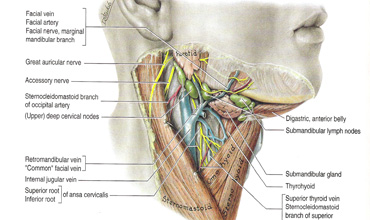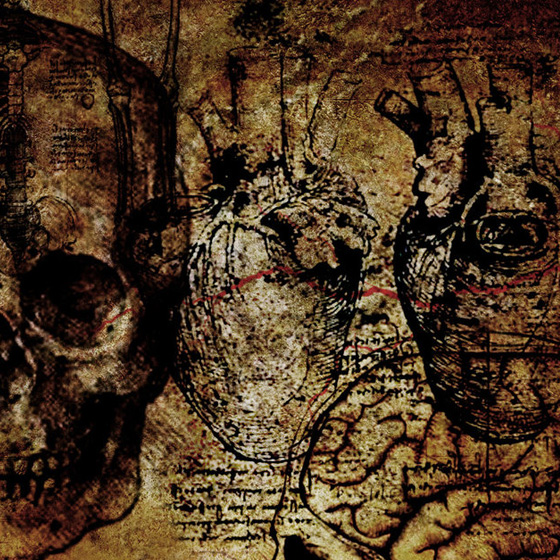Study of the Structural Variations in Musculature of Submental Region of the Neck with Emphasis on Digastric Muscle and its Clinical Implications

Abstract:
Anatomical variation in submental region especially
the digastric muscles are common& its knowledge is important for surgical
purpose. The anterior belly of the digastric muscle varies greatly in its shape
and size. It is important to know the variation of the digastric muscle, as it
is used as a landmark in certain surgical procedures, especially for surgeons
operating in the submandibular and submental region. The digastric muscle is
formed by two muscle bellies: one anterior and one posterior, joined by an
intermediate tendon. It is localized in the anterior cervical region. The
anterior belly divides the region between the hyoid bone & the mandible
into two, a lateral (submandibular) & a medial (submental triangle).This
muscle participates in deglutition & mandibular movements.
30 formalin fixed cadavers were
dissected, out of which 28 suprahyoid
regions showed a single anterior belly of digastric muscle bilaterally, with an
average length of 4.7 cm originating from the digastric fossa of the mandible
and had insertions on the intermediate tendon. Anatomical variation in the
anterior belly of the digastric muscles was noted in two cadaveric specimens
that showed additional muscular strips unilaterally. Knowledge of the
variations of the digastric muscle may prevent complications when surgery is
performed in the suprahyoid region (anterior region of the neck) or during
reporting of imaging techniques of the same as well as when differentiating
between cervical masses.
Key Words: Digastric
muscle, Anterior belly, Accessory ant. Belly, Variations, Intermediate tendon,
Suprahyoid region.
References:
[1]. Andreo, J. C.; Navarro, J. A. C.
& Toledo, Filho, J. L. Anatomical study on the variations of the anterior
belly of the digastric muscle. Rev. Chil. Anat., 15 (1):111-4, 1997.
[2]. Aktekin M, Kurtolu Z, Öztürk AH. A
bilateral and symmetrical variation of the anterior belly of the digastric
muscle. Acta MedOkayama 2003; 57: 205-7.
[3]. Akk›n SM, Özkufl K. M.
digastricus’un venter anterior varyasyonlar› n›n de¤erlendirilmesi. Çukurova
Üniversitesi T›p FakültesiDergisi 1992; 17: 248-55.
[4]. Bergman, R.A., Afifi, A. K., &
Miyauchi R., Digastricus. In: Illustrated Encyclopedia of Human Anatomic
Variation. Opus I: Muscular system; 2002.
[5]. Celik H H., Aldur M M., Ozdemir B.,
Aksit M D., Abnormal digastric muscle with unilateral quadrification of the
anterior belly. Clinical anatomy(New York, N.Y.) 2002,15(1):32-4.
[6]. Connell BF, Shamoun JM. The
significance of digastric muscle contouring for rejuvenation of the submental
area of the face. Plast Reconstr Surg 1997; 99: 1586-90.
[7]. Drake, R. L.; Vogl, W. &
Mitchell, A. W. M. Cabeça e pescoço. In: Drake, R. L.; Vogl, W. & Mitchell,
A. W. M. Gray’s Anatomia para estudantes. 1ª ed. Rio de Janeiro, Elsevier,
2005. pp. 905- 7.
[8]. Fujimura A.; Onodera, M, Feng, X. et
al. Abnormal anterior belly of the digastric muscle: A proposal for the
classification of abnormalities. Anat. Science Inter., 78:185-8,2003.
[9]. Guelfguat M, Nurbhai N, Solounias N.
Median accessory digastric muscles: radiological and surgical correlation. Clin
Anat 2001; 14: 42-6.
[10]. Holibkova A, Machalek L. A report on
anomalies of digastric muscle. Acta Univ Palacki Olomuc Fac Med 1999; 142:
57-9.
[11]. Lockhart R. D., Hamilton G. F.,
& Fyfe F. W., Músculos. In: Lockhart R.D., Hamilton G. F. & Fyfe, F. W.
editores. Anatomía do corpo humano. 2a ed. Rio de Janeiro, Guanabara Koogan,
1983, 156-7.
[12]. Liquidato, B. M.; Barros, M. D.;
Alves, A. L. & Pereira, C. S. B. Anatomical study of the digastric muscle: Variations
in the anterior belly. Int. J. Morphol., 25(4):797-800, 2007.
[13]. Moore K. L. & Persaud,T. V N.
Aparelho Faríngeo. In: Moore, K. L. & Persaud,T. V N. editores. Embriología
clínica. 7a ed. Rio de Janeiro, Editora Elsevier, 2004, 226-35.
[14]. Mascaro, MB., Picoli LC., Santos
FM., Bonsi, AB., Souza, MR. and Prosdócimi, FC.Anatomical variation of the
anterior belly of the digastric muscle: case report and clinical implications Morphol.
Sci., 2011, vol. 28, no. 1, p. 72-75.
[15]. Norton MR (1991) Bilateral accessory
digastric muscles. Br J Oral Maxillofac Surg, 29: 167–168.
[16]. Peker T, Turgut HB, An›l A.
Bilateral anomaly of anterior bellies of digastric muscles. Surg Radiol Anat
2000; 22: 119-21.
[17]. Peker T., Turgut H. B., & Anil
A., Bilateral anomaly bellies of digastric muscle, Surg. Radiol. Anat, 2000,
22:119-21.
[18]. Reyes G., Contreras C., Ramirez LM.,
Ballesteros LE., The digastric muscles anterior accessory belly: Case report,
Med Oral Patol Oral Cir Bucal, 2007,12:E341-3.
[19]. Sarikcioglu L, Demir S, Onus N,
Sindel M. An abnormal digastrics muscle with three accessory bellies and one
fibrous band. SurgRadiol Anat 1998; 20: 453-4.
[20]. Sargon MF., Celik HH., An abnormal
digastric muscle with three bellies, Surg Radiol Anat, 1994, 16:215-6.
[21]. Standring Susan, Gray's Anatomy, The
Anatomical Basis of Clinical Practice, 39th edi., Elsevier Churchill
Livingstone, Philadelphia, 2005. pp. 537.
[22]. Snell, R. S. A cabeça e o pescoço.
In: Snell, R.S. editor. Anatomiaclínica para estudantes de Medicina. 5ª ed. Rio
de Janeiro, Guanabara Koogan, 1999. pp. 611-7.
[23]. Sociedade Brasileira de Anatomia.
Terminologia Anatômica. Terminologia Anatômica Internacional. 1ª ed. São Paulo,
anole, 2001. pp. 3-4.
[24]. Sargon M.. F., & Celik H. H., An
abnormal digastric muscle with three bellies. Surg. Radiol. Anat.,1994,
16:215-6.
[25]. Turan-Ozdemir, S.; Oygucu, IH; &
Kafa, IM. Bilateral abnormal anterior bellies of digastric muscles. Anat.
Science Int., 79:95-7,2004.
[26]. Testut L.,. Traite D.,' Anatomie
Humaine. Paris, Octave Doin, 1905, 752-5.
[27]. Uzun A, Aluclu A, Kavakli A (2001)
Bilateral accessory anterior bellies of the digastric muscle and review of the
literature. Auris Nasus Larynx, 28: 181–183.
[28]. TAN, ST. Anterior belly of digastric
muscle transfer: a useful technique in head and neck surgery. New York Head and
NeckSociety, 2002, vol. 24, no. 10, p. 947-54.
[29]. TERZIS, JK. and TZAFETTA, K.
“Babysitter” procedure with concomitant muscle transfer in facial paralysis.
Plastic and Reconstructive Surgery, 2009, vol. 124, no. 4, p. 1142-56.
[30]. V. Mehta, V. Gupta, J. Arora, Y.
Yadav, R. K. Suri, G. Rath Bilateral bipartite origin of the posterior belly of
digastric muscle: a clinico-anatomical appraisal. Int. journal of exp. and cli.
Anat. Published online: November, 2010doi:10.2399/ana.09.042.
[31]. Williams LP, Warwick R, Dyson M and
Bannister LH (1989). Gray’s Anatomy. Churchill Livingstone, London, 37th ed. pp
539-540.
[32]. Yamada, S. Beobachfunger iiber der
Venter anterior des Musculus digastricus mandibulae bei japanisher Erwachsenen
und Foeter. Acta Anat. Nippon., 8:303-47, 1935.
[33]. Zlabek, K. Contribution a la
connaissance des anomalies du ventre anterieur du digastrique de l'Homme. Arch.
Anat. Histol. Embryol., 16:357-406, 1933.

